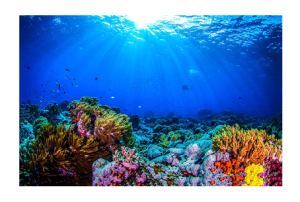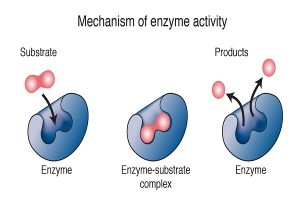Assist. Prof. Dr . Hanan Zweer
College Of Education For Pure Sciences / Department Of Biology
Coral is a marine invertebrate belonging to the phylum Cnidaria, which was previously thought to be an organism between inanimate objects and plants. Coral diameter not more than 2.5 cm. The shape of the body is polyp or cylindrical. The mouth opening is located at the upper end, which is surrounded by tentacles, and below the basal end, which adheres to solid surfaces, lives as colonies in tropical oceans, thus forming different types of coral islands. Their colors vary between red, which is the best type, yellow and orange.
Coral is the first animal responsible for the formation of reefs and therefore corals are called coral reefs. Corals are colonies of organisms that grow and stick to the bottom, each of which includes hundreds or even thousands of tiny and micro animals called polyps. Where each polyp shares with its counterparts the formation of a single colony whose shape and external composition vary according to the type of coral. Coral colonies that are reefs in a state of continuous growth for this the reefs continue to grow in a vertical direction and grow until they reach near the surface of the water and then begin to grow in the lateral direction to increase their width and the size of the reefs is related to the duration of their presence in the region as well as the presence of factors that help their growth and reproduction and the growth of coral is estimated at about 1 cm to 3 cm per year depending on the type of coral and the surrounding environmental conditions, which indicates the slow growth of this organism. So the rate of coral growth is very slow, taking a thousand years for corals to grow by just three feet. There are more than 150 million square meters of land covered by coral reefs.
Coral reefs are unique ecosystems formed from calcium carbonate deposits that harden over the years as they spend their lives glued to rocks. The colonies coexist with Zooxanthellae, which is found within the tissues of coral polyps and provides more than 98 percent of its nutritional needs; it carries out photosynthesis – the conversion of carbon dioxide into oxygen and carbohydrates using solar energy – so corals can only survive in clear, shallow water; so sunlight can easily reach them Zooxanthellae can produce organic matter through photosynthesis, which is then excreted in the host.
Coral has medical, environmental and economic importance, as its chemical compounds are used to treat cancer, AIDS, pains, bone transplantation and replacement, treatment of blood diseases, skin diseases, and many medicines are now being developed from animals and plants of coral as potential treatments for cancer, arthritis, bacterial and viral infections and other diseases.
Coral colonies provide places for marine animals to be found, protected and provided with food, they are considered a shelter for algae and thus benefit from photosynthesis products. The cracks in the solid coral mass provide adequate shelter and feeding places for seaworms, sponges, mollusks, crabs, shrimp, fish, Crustaceans, snails, oysters and echinoderms, such as sea urchins, anemones, sea cucumbers, starfish, and reptiles such as sea snakes and sea turtles. Some scientists estimate that there are as many as 8 million other undiscovered species of organisms that reside around and within coral reefs.
The work of coral colonies in the sea is similar to the work of forests, as they provide oxygen, slow down the speed of water currents and thus prevent erosion of the land, they are considered as natural buffers to protect coasts against erosion forces, as coral reef structures protect beaches against 97 percent of the energy generated by waves, storms and floods, which helps prevent loss of life, destruction of property and erosion.When coral reefs are damaged or destroyed, the lack of this natural barrier can increase the damage to coastal communities from normal wave traffic and violent storms, such as fishing grounds. A tourist attraction, global diving tourism contributes $ 4.5 billion, as a natural laboratory for research and education, coral is also an organic stone used in the manufacture of jewelry, as well as used as a building stone. There are international laws governing coral hunting and trade .There are factors influencing the development of coral reefs, such as light, heat and salinity, and these conditions are also closely related to the movements of water caused by both waves and ocean currents.
References
⦁ Balasubramania A..(2013).CORAL REEFS & ATOLLS. University of Mysore.Pp8.
2-Rowan R, Knowlton N. Intraspecific diversity and ecological zonation in coral-algal symbiosis. Proc. Natl. Acad. Sci. USA. 1995; 92(7):2850- 2853.
3- Mojetta A. White Star Guides: Underwater Word: Coral Reef. White Star Publishers: Vercelli, Italy, 2003
4- Sorokin YI. Coral reef ecology. Springer Science & Business Media, 2013, 102.
5- Allen GR, Werner TB. Coral reef fish assessment in the ‘coral triangle’of southeastern Asia. Environmental Biology of Fishes. 2002; 65(2):209-214.
6- Edinger EN, Jompa J, Limmon GV, Widjatmoko W, Risk MJ. Reef degradation and coral biodiversity in Indonesia: effects of land-based pollution, destructive fishing practices and changes over time. Marine Pollution Bulletin. 1998; 36(8):617-630.
7- Suzuki A, Kawahata HJ, Tellus B. Carbon budget of coral reef systems: an overview of observations in fringing reefs, barrier reefs and atolls in the Indo-Pacific regions. Tellus. 2003; 55(2):428-444.
8-The staff of the Coral Reef Alliance.(2003). Introduction to Coral Reef Ecosystems, Threats, and Solutions.Pp75.































































